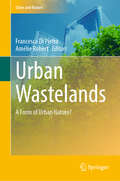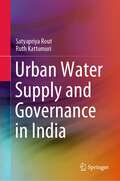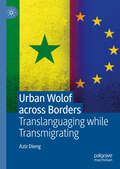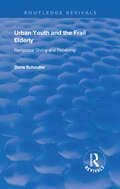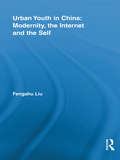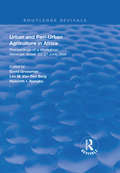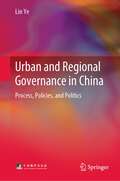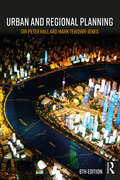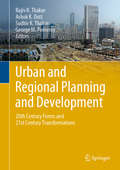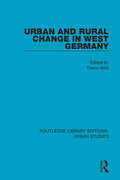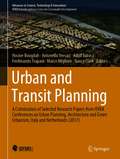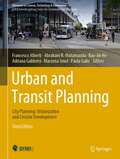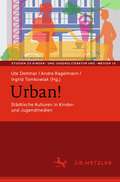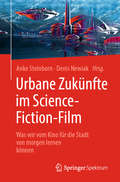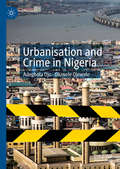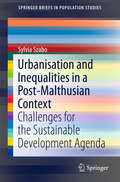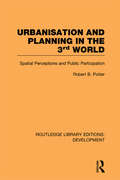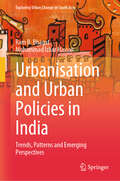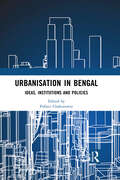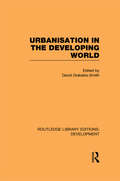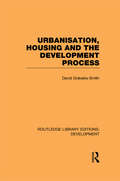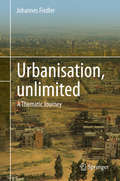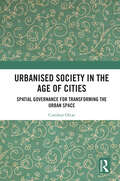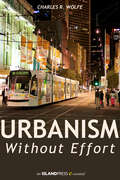- Table View
- List View
Urban Warfare: Housing under the Empire of Finance
by Raquel RolnikHow finance and politics have caused the global housing crisisThe most comprehensive survey of the current crisis, Urban Warfare charts how the financial crisis and wider urban politics have left millions homeless and in financial desperation across the world.The financialisation of housing has become a global catastrophe, leaving millions desperate and homeless. Since the 2008 financial collapse, models of home ownership, originating in the US and UK, are being exported around the world. Using examples from across the globe, Rolnik shows how our cities have been sold to construction companies and banks, while supported by government-facilitated schemes, such as “the right to buy” subsidies and micro-financing. Our homes and neighbourhoods have become the “last subprime frontiers of capitalism,” organised by those who benefit the most.
Urban Wastelands: A Form of Urban Nature? (Cities and Nature)
by Francesca Di Pietro Amélie RobertFaced with the growing demand for nature in cities, informal greenspaces are gaining the interest of various stakeholders - residents, associations, public authorities - as well as scientists. This book provides a cross-sectorial overview of the advantages and disadvantages of urban wastelands in meeting this social demand of urban nature, spanning from the social sciences and urban planning to ecology and soil sciences. It shows the potential of urban wastelands with respect to city dwellers’ well-being, environmental education, urban biodiversity and urban green networks as well as concerns regarding urban wastelands’ in relation to conflicts, and urban marketing. The authors provide a global insight through case studies in nine countries, mainly located in Europe, Asia and America, thus offering a broad perspective.
Urban Water Supply and Governance in India
by Ruth Kattumuri Satyapriya RoutThis book investigates institutional dimensions of urban water supply in India, with a specific focus on institutional capabilities to provide drinking water to urban households in an efficient, equitable and sustainable manner. This book has been developed through empirical research within the context of growing urbanisation and increasing water needs of Indian cities, and the wider developmental goal of achieving universal and equitable access to safe and affordable water for all – as envisaged in goal 6 of the SDGs.This study revolves around three important aspects of urban water supply and governance. Firstly, it attempts to understand household water service delivery scenarios in urban India, drawing from case studies based on our household survey in four cities – Ahmedabad, Bangalore, Kochi and Hyderabad. Secondly, it examines the question of existing socio-economic inequality and access to water in an urban context in India. While dealing with the issue of inequality and access to water, it attempts to explore the question of whether access to water and water scarcity is socially neutral; whilst also analysing the mechanisms employed by the urban poor to manage their daily water needs. Thirdly, this book explores the role of institutions for efficient and effective delivery of water in urban India. The institutional analysis from a comparative perspective provides important insights to guide current reforms in domestic water supply in India, especially in a neo-liberal context. The book is a valuable resource for academicians, policy makers and practitioners involved in water governance in general and domestic (drinking) water supply in particular. Besides, it is of great interest to those working in the area of urban development, urban planning and household water management. The book is an outcome of a collaborative research project by the authors sponsored jointly by University Grants Commission (UGC), New Delhi and UK-India Education and Research Initiative (UKIERI).
Urban Wolof across Borders: Translanguaging while Transmigrating
by Aziz DiengThis book takes urban Wolof beyond Senegal to consider the effects of mobility on language and examine how the diasporans engage in their daily language practices as transmigrants. The parallel between languaging and migrating underpins the author's argument, as he examines the dynamicity of languaging at both micro and macro levels, as speakers navigate across spaces and languages. Moving away from a code-based approach, the author makes a compelling case that the urbanite, rather than shuttling between codes, deploys instead idiolectal features from a unique linguistic repertoire which comprises at once semiotic, cognitive, and language features. His indigenous approach affords novel perspectives in linguistic ethnography and complements the Euro-Western methodologies.
Urban Youth and the Frail Elderly: Reciprocal Giving and Receiving
by Doris SchindlerThere are two groups of urban residents who, although quite unlike each other, can complement each others' needs. They are the frail elderly and low-income teenagers. This study is about Project MAIN: The frail elderly need help with grocery shopping, and low-income teenagers need an income-generating jobs program so that they may earn some money. The matching of needs in Project Main was an attempt to coordinate disparate community demographics in a mutually beneficial way
Urban Youth in China: Modernity, The Internet And The Self (Routledge Research in Information Technology and Society)
by Fengshu LiuFengshu Liu situates the lives of Chinese youth and the growth of the Internet against the backdrop of rapid and profound social transformation in China. In 2008, the total of Internet users in China had reached 253 million (in comparison with 22.5 million in 2001). Yet, despite rapid growth, the Internet in China is so far a predominantly urban-youth phenomenon, with young people under thirty (especially those under twenty-four), mostly members of the only-child generation, as the main group of the netizens’ population. As both youth and the Internet hold the potential to inflict, or at least contribute to, far-reaching economic, social, cultural, and political changes, this book fulfills a pressing need for a systematical investigation of how youth and the Internet are interacting with each other in a Chinese context. In so doing, Liu sheds light on what it means to be a Chinese today, how ‘Chineseness’ may be (re)constructed in the Internet Age, and what the implications of the emerging form of identity are for contemporary and future Chinese societies as well as the world.
Urban and Peri-urban Agriculture in Africa: Proceedings of a Workshop, Netanya, Israel, 23-27 June 1996 (Routledge Revivals)
by David Grossman Leo M. van den Berg Hyacinth I. AjaegbuPublished in 1999, this work sets out to assess the potential of urban and peri-urban agriculture for generating income and for improving food supply for the growing urban population in Africa. It considers both full-time small-holder farmers and part-timers, who hold land under various tenurial conditions. Since the book is a collection of papers based on field studies, it contains a wide range of approaches, methods of investigation, and scientific findings.
Urban and Regional Governance in China: Process, Policies, and Politics
by Lin YeThis book examines the process, policies, and politics of urban development in China, with particular attention to city region governance, urban redevelopment, and urban–rural interaction through intensive theoretical discussions and extensive case studies. It offers ample data, pictures, and illustrations to provide readers with a deep understanding of urban policies and policies in China. The regional and metropolitan perspective is emphasized to analyze the urban–rural transition and how it affects urban governance. This book develops a well-grounded political economy analysis to examine how city region development and governance evolve in China. Such development is the focal point of China’s continuing urbanization, and its impact needs to be carefully analyzed. In the end, this book aims to foster discussions that may lead to serious consideration on China’s future urbanization route.
Urban and Regional Planning
by Peter Hall Mark Tewdwr-JonesThis is the sixth edition of the classic text for students of urban and regional planning. It gives a historical overview of the developments and changes in the theory and practice of planning throughout the entire 20th and first part of the 21st centuries. The extensively revised edition incorporates the most important developments in recent times: debates on economic rebalancing and national infrastructure including high speed rail, energy, millennium projects, Celtic devolution, European influence, impact of London on nation. A new chapter "Planning for cities and city regions 1990-2017": includes new material on housing, localism, neighbourhood planning, privatisation, city modernism, reform, Devo and city deals and metro mayors. Urban and Regional Planning will be invaluable to undergraduate as well as postgraduate Planning students. It will prove useful in a variety of built environment areas such as Architecture, Landscape Architecture, Urban Design, Real Estate where planning is taught.
Urban and Regional Planning and Development: 20th Century Forms and 21st Century Transformations
by Ashok K. Dutt Rajiv R. Thakur Sudhir K. Thakur George M. PomeroyThis book discusses urban planning and regional development practices in the twentieth century, and ways in which they are currently being transformed. It addresses questions such as: What are the factors affecting planning dynamics at local, regional, national and global scales? With the push to adopt a market paradigm in land development and infrastructure, the relationship between resource management, sustainable development and the role of governance has been transformed. Centralized planning is giving way to privatization, not only in the traditional regions but also in newly emerging regions of Asia, Africa and Latin America. Further, attempts are being made to bring planning related decision-making closer to the people who are most affected by it. Presenting a collection of studies from scholars around the world and highlighting recent advances in the field, the book is a valuable reference guide for those engaged in urban transformations, whether as graduate students, researchers, practitioners or policymakers.
Urban and Rural Change in West Germany (Routledge Library Editions: Urban Studies #24)
by Trevor WildOriginally published in 1983. Attention is focused in this book on the principal functional, spatial and morphological changes which had taken place within West Germany’s uniquely arranged mosaic of cities, towns and intervening rural areas during the postwar period. The topics covered here have been carefully selected as key foci of interest, and their thematic approach is supported by a large variety of detailed, local case studies. This title will be of interest to students of urban geography and urban studies.
Urban and Transit Planning: A Culmination of Selected Research Papers from IEREK Conferences on Urban Planning, Architecture and Green Urbanism, Italy and Netherlands (2017) (Advances in Science, Technology & Innovation)
by Nancy Clark Hocine Bougdah Antonella Versaci Adolf Sotoca Ferdinando Trapani Marco MiglioreA volume of five parts, this book is a culmination of selected research papers from the second version of the international conferences on Urban Planning & Architectural Design for sustainable Development (UPADSD) and Urban Transit and Sustainable Networks (UTSN) of 2017 in Palermo and the first of the Resilient and Responsible Architecture and Urbanism Conference (RRAU) of 2018 in the Netherlands. This book, not only discusses environmental challenges of the world today, but also informs the reader of the new technologies, tools, and approaches used today for successful planning and development as well as new and upcoming ones. Chapters of this book provide in-depth debates on fields of environmental planning and management, transportation planning, renewable energy generation and sustainable urban land use. It addresses long-term issues as well as short-term issues of land use and transportation in different parts of the world in hopes of improving the quality of life. Topics within this book include: (1) Sustainability and the Built Environment (2) Urban and Environmental Planning (3) Sustainable Urban Land Use and Transportation (4) Energy Efficient Urban Areas & Renewable Energy Generation (5) Quality of Life & Environmental Management Systems. This book is a useful source for academics, researchers and practitioners seeking pioneering research in the field.
Urban and Transit Planning: City Planning: Urbanization and Circular Development (Advances in Science, Technology & Innovation)
by Francesco Alberti Abraham R. Matamanda Paola Gallo Adriana Galderisi Bao-Jie He Marzena SmolThis book represents a compilation of research in sustainable architecture and planning. Its main focus is offering strategies and solutions that help reducing of the negative impacts of buildings on the environment and emphasizing the suitable management of available resources. By tackling the topic of sustainability from a historical perspective and also as a vision for the future, the book in hands provides new horizons for engineers, urban planners and environmentalists interested in the optimization of resources, space development, and the ecosystem as a whole to address the complex unresolved problems our cities are facing. This book is a culmination of selected research papers from IEREK’s sixth edition of the International Conference on Urban Planning & Architectural Design for Sustainable Development (UPADSD) held online in collaboration with the University of Florence, Italy (2021) and the first edition of the International Conference on Circular Economy for Sustainable Development (CESD) held online in collaboration with the University of Salento, Lecce, Italy (2021).
Urban!: Städtische Kulturen in Kinder- und Jugendmedien (Studien zu Kinder- und Jugendliteratur und -medien #13)
by Ute Dettmar Ingrid Tomkowiak Andre KagelmannAls literarischer Handlungsraum hat sich die Stadt, vor allem die Großstadt, sowohl mit Blick auf die Erzählformen als auch in den semantischen Zuschreibungen innerhalb von etwa 150 Jahren grundlegend gewandelt. Im kinder- und jugendliterarischen Umgang mit den urbanen Räumen werden Veränderungen der Konstruktionen von Kindheit und Adoleszenz ebenso manifest wie die Ausdifferenzierung der Erzählformen. Heute wird Stadt als ein plurales, vielstimmiges und vielschichtiges Gefüge dargestellt, das auch von sozialen Gegensätzen geprägt und von intersektionalen Grenzlinien durchzogen ist. Die Beiträge dieses Bandes untersuchen Dimensionen und Facetten der erzählten Stadt und geben einen Einblick in das thematische und formale Spektrum kinder- und jugendliterarischer Stadterkundungen. Dabei nehmen sie Kinder- und Jugendromane, Kriminalerzählungen, Dystopien und Fantasy, Lyrik und Theater in den Blick.
Urbane Zukünfte im Science-Fiction-Film: Was wir vom Kino für die Stadt von morgen lernen können
by Ferdinando TerelleDieses Buch bietet eine außergewöhnliche Perspektive auf die nachhaltige, lebenswerte und humane Gestaltung urbaner Zukünfte, indem es sich dieser Herausforderung mit Blick auf das Science-Fiction-Kino sowie mit Bezügen zu Literatur, Architektur und Design nähert.Schon im Jahr 2050 sollen mehr als zwei Drittel aller Menschen in Ballungsräumen leben. Doch Großstädte laufen bereits heute Gefahr, an ihre Leistungsgrenzen zu stoßen: In den Megacities drohen Überbevölkerung, Verkehrschaos, Luftverschmutzung und Vereinsamung. Auf welche Weise werden solche zukünftig immer drängenderen Probleme in den fiktionalen Welten von Genreklassikern und aktuellen Blockbustern gelöst? Was lässt sich aus den fantastischen Zukunftsentwürfen zur Bewältigung urbaner Herausforderungen lernen?mediale und nachhaltige Großstadt-Architekturen New-Work-Designs und -KonzepteStrategien gegen gesellschaftliche SpaltungZu diesen und anderen Themen zeigen die Autoren eine Vielzahl von Ideen für die Stadtplanung der Zukunft auf und plädieren für das Nutzbarmachen kreativer Potenziale bei der Gestaltung lebenswerter Umgebungen.
Urbanisation and Crime in Nigeria
by Adegbola Ojo Oluwole OjewaleThis book uses crime-science and traditional criminological approaches to explore urban crime in the rapidly urbanising country Nigeria, as a case study for urban crime in developing nations. In Africa’s largest democracy, rapid unmanaged growth in its cities combined with decaying public infrastructure mean that risk factors accumulate and deepen the potential for urban crime. This book includes a thorough explanation of key concepts alongside an examination of the contemporary configuration, dynamics, dimensions, drivers and potential responses to urban crime challenges. The authors also discuss a range of methodological techniques and applications that can be used, including spatial technologies to generate new data for analysis. It brings together history, theory, trends, patterns, drivers, repercussions and responses to provide a deep analysis of the challenges that confront urban dwellers. Urbanisation and Crime in Nigeria offers academics, researchers, governments, civil society organisations, citizens, and international partners a tool with which to engage in a serious dialogue about crime within cities, based on evidence and good practices from inside and outside sub-Saharan Africa.
Urbanisation and Inequalities in a Post-Malthusian Context
by Sylvia SzaboThe book examines contemporary urban challenges andopportunities within the context of the traditional Malthusian theory. The bookreorients the classic Malthusian debate on population and food by focusing onglobal urbanisation and its consequences for peoples' access to basic means ofsubsistence. Case studies from bothdeveloping and developed countries provide a comprehensive overview of theissues related to availability of food and water in an urban context. The booksuggests that the concern for human survival is still relevant and can beexacerbated by rapid urbanisation, and that the negative impacts of urbanprocesses require an increased attention of the international community as weenter the new Sustainable Development Goals era.
Urbanisation and Planning in the Third World: Spatial Perceptions and Public Participation (Routledge Library Editions: Development)
by Robert PotterFirst published in 1985, this book reconsiders the whole question of urbanisation and planning in the Third World. It argues that public involvement, which is now an accepted part of Western planning, should be used more in Third World cities. It shows that many inhabitants of Third World cities are migrants from rural areas and have very definite ideas about what the function of the city should be and what it ought to offer; and it goes on to argue that therefore a planning process which involves more public participation would better serve local needs and would do much more to solve problems than the contemporary approach.
Urbanisation and Urban Policies in India: Trends, Patterns and Emerging Perspectives (Exploring Urban Change in South Asia)
by Mohammad Izhar Hassan Ram B. BhagatThe volume examines urbanization and migration trends and their patterns in the light of India's emerging urban policy, planning and governance perspectives. It sheds light on the differences in urbanization between developed and less developed parts of the world, with a particular focus on India. It studies migration in general and rural to urban migration particular which plays a significant role in economic and urban transition. The chapters highlight important methodological issues in determining the nature of ‘urban’ and the magnitude of internal migration. Furthermore, the book presents the contributions of different factors to urban population growth, including natural increase, net rural-to-urban migration, and net rural-to-urban classification, to reflect the relationship between economic development and urbanization. It also elaborates on the regional economic disparities in India and its association with urbanization. The book elucidates the opportunities and challenges of urbanisation, presents explanations and perspectives from various theoretical and epistemological standpoints emphasising the role of a people centric inclusive urbanisation in sustainable development and human wellbeing. The book is aligned with SDG Goal 11, which emphasizes the need to make cities and human settlements inclusive, safe, resilient, and sustainable. It distinguishes between urban development policies focused solely on cities and their issues and urbanisation policies. Overall, this book is a valuable resource for researchers, students, and teachers of city planning, urban development, and urban studies, as well as policymakers.
Urbanisation in Bengal: Ideas, Institutions and Policies
by Pallavi ChakravartyThis volume presents a comprehensive study of the urbanization of Bengal from ancient to postcolonial times. It analyses the notion of urban space, examines the institutions which constitute the ‘urban’, and explores the crises brought about by the Partition.The book highlights the key features of urbanization in colonial Bengal––the print culture, institutions of Western education and Western medicine, and the census as a ‘modern form of knowledge’. It also looks at the refugee movement and discusses the contribution of Partition refugees in urbanizing Bengal.Rich in archival sources, this book will be indispensable for scholars and researchers of urban history, urban studies, Indian history, colonial history, postcolonial studies, partition studies, and South Asian history, particularly those interested in Bengal.
Urbanisation in the Developing World (Routledge Library Editions: Development)
by David Drakakis-SmithFirst published in 1986, this reissue is concerned with the increased social problems, regional imbalances, and economic dislocation resulting from the alarming growth rate of cities in the developing world. It considers theoretical questions and contains wide-ranging case studies to support the arguments made. It relates urbanisation in the developing world to changes in the broader global economic system, as well as looking at the urbanisation process over time.
Urbanisation, Housing and the Development Process (Routledge Library Editions: Development)
by David Drakakis-SmithInitially published in 1981, this book examines the problems of housing provision for the urban poor in developing countries, within the context of the development process as a whole. The investigation concentrates on the political economy of housing investment and illustrates how programmes and policies are often determined by broader development issues. Commencing with a discussion of urban growth in the Third World, the author then provides a general discussion on housing provision within contemporary development planning in the Third World. Four main types of accommodation – government construction, private sector, squatter housing and slum – are examined in terms of their contemporary and potential roles in meeting low cost housing needs. Drawing on evidence from a number of Asian countries, the study argues that the real needs of the urban poor are not being met, and that other political and economic objectives, set by the established elites of society, predominate.
Urbanisation, unlimited
by Johannes FiedlerIn a series of essays, the process of urbanisation - a human mega-trend acquiring unprecedented scale and speed as globalisation proceeds - is examined in the most diverse contexts and stages of development. Drawing on scientific references and identifying recurring themes like dispersion, privatisation and vitality, Fiedler devises the glossary for a cross-cultural understanding of the global urban system emerging. Images and anecdotal evidence reconnect these themes to local realities. The tone of the essays conveys a post-voluntarist attitude, derived from many years of professional experience - critical of both neoliberal practices and determinist ideas. To "condemn the reality" of global urbanization "is fruitless", writes Johannes Fiedler in this unlimited view of a world of constant motion, subject no longer to just its planetary rotations, but also to the constant push and pull of its various populations, some of whose giant constructions shift the earth's axis. From the foreword by Lars Lerup
Urbanised Society in the Age of Cities: Spatial Governance for Transforming the Urban Space
by Cumhur OlcarThis book details the transformation processes that impinge on constitutionally ordained governance by drawing on the new theoretical approaches in the urban sciences. It is unique in terms of its focused content, which thoroughly analyses the transformation of space and governance in Turkey and beyond and how urban institutions have emerged and changed since their inception.Underlining the distinct structural characteristics, this book unearths the significant socio-political and economic processes which are critical to the political articulation of governance in cities. It follows a multidisciplinary approach which helps understand ‘the social churning’ that has radically altered the conventions of urban politics. It also attempts to draw out the theoretical implications of cities’ peculiar socio-economic and political processes, based on a rigorous empirical investigation, in which ‘political’ is envisioned and fashioned.This book will be useful to students, researchers and teachers working in the field of urban and social science, public administration, urban sociology, political economy and urban politics. It will also be an invaluable and interesting reading for those invested in Asian studies.
Urbanism Without Effort
by Charles R. WolfeThis beautifully illustrated short e-book explores the idea that to create vibrant, sustainable urban areas for the long term, we must first understand what happens naturally when people congregate in cities--innate, unprompted interactions of urban dwellers with each other and their surrounding urban and physical environment. Wolfe elaborates on the perspective that the underlying rationales for urban policy, planning and regulation are best understood from a historical perspective and in a better understanding of the everyday uses of urban space. To make his case, Wolfe draws on his years of writing about urbanism as well as his professional experiences as a land use and environmental lawyer and offers compelling case study vignettes from everyday urban life. Successful community, Wolfe argues, is among the first principles of what makes humans feel happy, and therefore city dwellers invariably celebrate environments where and when they can coexist safely, in a mutually supportive way. Wolfe believes such celebration is most interesting when it occurs spontaneously--seemingly without effort. He contends it is critical to first isolate these spontaneous and latent examples of successful urban land use, before applying any prescriptive government policies or initiatives. Wolfe provides something rare in contemporary urbanist writing--rich illustrations and examples from real life--both historical and current. His writing about the past and the future of urban form offers readers inspiration, historical context, and a better understanding of how a sustainable, inviting urban environment is created.

